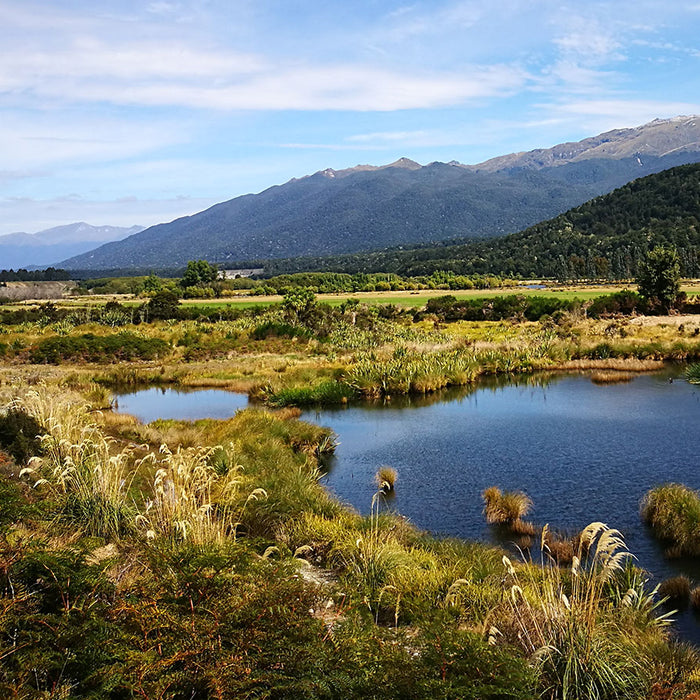Welcome to Greenmachine’s Care & Advice hub. Based in Tuatapere, Southland, we grow hardy New Zealand natives from seed to sale and ship them nationwide.
This guide is designed to help you select, plant, and maintain your native plants so they thrive in gardens and landscapes across Aotearoa.
Choosing the Right Native Plant for Your Space
Light, Position and Microclimate
New Zealand has a wide range of climates and growing conditions. When selecting natives:
-
Full sun or exposed sites: Ideal for many tussocks, flaxes (harakeke), and coastal species.
-
Sheltered or semi-shaded areas: Best for shrubs and small trees that prefer protection from harsh wind or sun.
-
Wind, salt spray, or exposed ridges: Choose hardy, wind-tolerant natives grown and tested in Southland’s challenging conditions.
Because Greenmachine grows plants outdoors in Southland weather, our plants are well-hardened for most New Zealand environments.
Soil and Drainage
-
Most natives prefer free-draining soil. If your soil is heavy or clay-based, mix in sand or fine gravel to improve drainage.
-
Raised beds or mounds can help prevent water-logging in wet areas.
-
For coastal or sandy sites, choose species adapted to salt and wind exposure.
Scale of Planting and Purpose
-
Small gardens: Compact shrubs and groundcovers work best.
-
Large landscapes or restoration projects: Greenmachine offers bulk quantities (sold in multiples of five or ten) for mass planting.
-
Wildlife value: Planting regionally appropriate natives supports native birds, bees, and insects.
Lifestyle and Maintenance
Native plants are naturally lower-maintenance when matched to the right site. However, all new plantings require care during their establishment phase — including watering, weeding, and protection from frost or browsing animals.
Watering and Establishment
During the First Year
Consistent watering is crucial while roots establish. Even drought-tolerant species benefit from steady moisture early on.
-
Check soil moisture regularly — if the top few centimetres are dry, it’s time to water.
-
Water deeply to reach the root zone.
-
Apply mulch around plants (without touching the stems) to conserve moisture and reduce weeds.
Long-Term Watering
Once established, many New Zealand natives are drought-tolerant. However:
-
In hot, dry summers, deep watering every few weeks helps maintain health.
-
Avoid overwatering or poor drainage — most natives dislike “wet feet.”
-
Greenmachine plants are grown in moist Southland conditions, so they adapt well but still need suitable drainage in other regions.
Container Plants
If you’re growing natives in pots, use a free-draining potting mix and ensure containers have drainage holes. Water thoroughly, then allow the top layer of soil to dry slightly before watering again.
Light, Temperature and Exposure
Light
-
Most native tussocks, flaxes, and shrubs thrive in full sun or part sun.
-
Understory natives prefer filtered or partial shade.
-
Indoors, place native species in bright, indirect light. Avoid dark corners.
Temperature and Climate
-
Southland-hardy plants can handle frost and cooler conditions.
-
In warmer or drier regions, choose species adapted to heat and drought.
-
Avoid placing young plants in areas with strong reflected heat from concrete or walls.
Wind and Exposure
-
Exposed or coastal sites benefit from wind-tolerant species.
-
Temporary windbreaks help young plants establish.
-
Check regularly for leaf damage from wind or salt exposure and adjust placement if needed.
Feeding and Soil Nutrition
Native Plant Nutrition
New Zealand natives are adapted to low-nutrient soils, so heavy fertilising is unnecessary.
-
Over-fertilising can cause soft growth that’s vulnerable to pests and wind damage.
-
Use a mild, balanced fertiliser or compost if soil is particularly poor.
-
Prioritise improving soil structure and drainage over chemical feeding.
Feeding Schedule
-
Apply a light organic fertiliser or compost in spring when growth begins.
-
In summer, an additional light feed can help support young plants in poor soils.
-
Reduce feeding in autumn and winter when growth slows.
Mulching
Mulch conserves water, regulates soil temperature, and suppresses weeds.
Use bark chips, composted wood, or leaf litter — materials that break down slowly.
Keep mulch away from plant stems to prevent rot.
Pruning, Repotting and General Maintenance
Pruning
-
Remove dead, damaged, or diseased foliage to maintain health.
-
Lightly prune shrubs after flowering to encourage dense growth.
-
For grasses and flaxes, trim back old leaves at the base in late winter or early spring.
Repotting and Transplanting
-
Repot container plants every one to two years into a slightly larger pot with fresh soil mix.
-
When planting outdoors, dig a hole twice as wide as the pot, plant at the same depth, firm the soil, and water thoroughly.
-
Mulch well after planting to protect roots.
Weed Control and Protection
-
Keep at least 30 cm around each plant free of weeds or grass during the first year.
-
Protect young plants from browsing animals, frost, and wind exposure where necessary.
-
Check regularly for pests such as slugs or caterpillars and remove by hand if possible.
Common Plant Problems and Solutions
| Problem | Likely Cause | Solution |
|---|---|---|
| Yellowing leaves | Poor drainage or frost damage | Improve drainage; protect from frost |
| Brown leaf tips | Wind burn, sun scorch, or drought stress | Water deeply; move to a more sheltered spot |
| Slow or stunted growth | Low light or poor soil quality | Improve light exposure; add organic matter |
| Pest damage | Browsing animals or insects | Use guards, traps, or safe natural deterrents |
| Plant collapse or rot | Waterlogging or planting too deep | Replant at correct depth; ensure free drainage |
Shipping and Arrival Care
Greenmachine ships plants directly from our Southland nursery to customers throughout New Zealand. When your plants arrive:
-
Unpack them immediately and water if the soil feels dry.
-
Keep them in a sheltered, shaded area for several days to recover from transit.
-
If planting straight away, follow the guidelines above.
-
If storing for a short time, keep pots moist and out of direct sun or strong wind.
If you have concerns about your order, contact us upon their arrival— we’re here to help ensure your plants arrive healthy and ready to thrive.






